2013 NISSAN GT-R fuel pressure
[x] Cancel search: fuel pressurePage 8 of 346
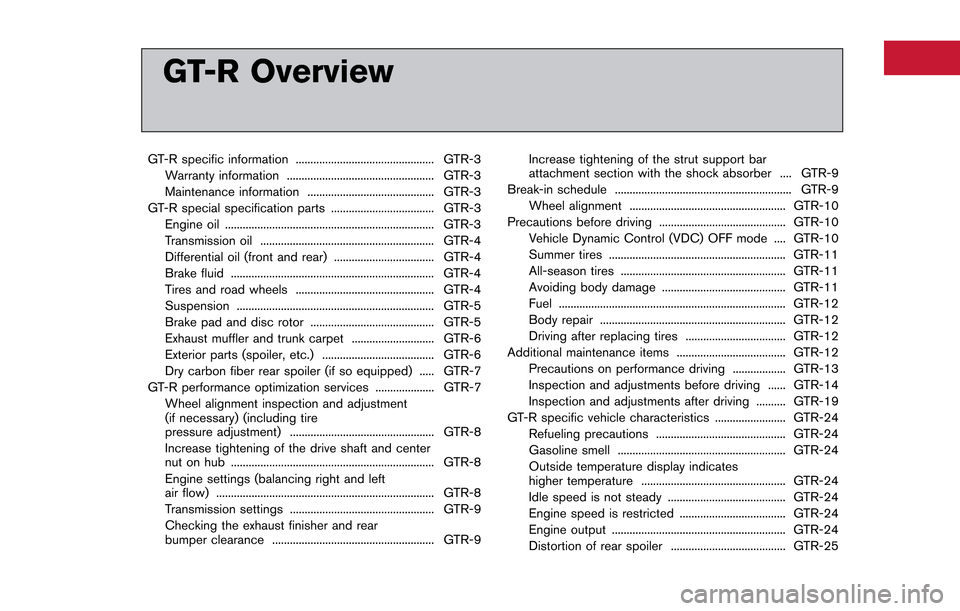
GT-R Overview
GT-R specific information ............................................... GTR-3Warranty information .................................................. GTR-3
Maintenance information ........................................... GTR-3
GT-R special specification parts ................................... GTR-3 Engine oil ....................................................................... GTR-3
Transmission oil ........................................................... GTR-4
Differential oil (front and rear) .................................. GTR-4
Brake fluid ..................................................................... GTR-4
Tires and road wheels ............................................... GTR-4
Suspension ................................................................... GTR-5
Brake pad and disc rotor .......................................... GTR-5
Exhaust muffler and trunk carpet ............................ GTR-6
Exterior parts (spoiler, etc.) ...................................... GTR-6
Dry carbon fiber rear spoiler (if so equipped) ..... GTR-7
GT-R performance optimization services .................... GTR-7 Wheel alignment inspection and adjustment
(if necessary) (including tire
pressure adjustment) ................................................. GTR-8
Increase tightening of the drive shaft and center
nut on hub ..................................................................... GTR-8
Engine settings (balancing right and left
air flow) ........................................................................\
.. GTR-8
Transmission settings ................................................. GTR-9
Checking the exhaust finisher and rear
bumper clearance ....................................................... GTR-9 Increase tightening of the strut support bar
attachment section with the shock absorber .... GTR-9
Break-in schedule ............................................................ GTR-9
Wheel alignment ..................................................... GTR-10
Precautions before driving ........................................... GTR-10 Vehicle Dynamic Control (VDC) OFF mode .... GTR-10
Summer tires ............................................................ GTR-11
All-season tires ........................................................ GTR-11
Avoiding body damage .......................................... GTR-11
Fuel ........................................................................\
..... GTR-12
Body repair ............................................................... GTR-12
Driving after replacing tires .................................. GTR-12
Additional maintenance items ..................................... GTR-12
Precautions on performance driving .................. GTR-13
Inspection and adjustments before driving ...... GTR-14
Inspection and adjustments after driving .......... GTR-19
GT-R specific vehicle characteristics ........................ GTR-24 Refueling precautions ............................................ GTR-24
Gasoline smell ......................................................... GTR-24
Outside temperature display indicates
higher temperature ................................................. GTR-24
Idle speed is not steady ........................................ GTR-24
Engine speed is restricted .................................... GTR-24
Engine output ........................................................... GTR-24
Distortion of rear spoiler ....................................... GTR-25
Page 20 of 346

PRECAUTIONS ON PERFORMANCE
DRIVING
The information and specifications in this
section apply only when engaging in
performance driving.
Checking the temperature of the
coolant and oils on the multi func-
tion display
When the temperatures of the engine coolant
and oil, and the oil pressure exceed the normal
range, the color of the meter on the multi
function display changes to red to warn the
driver. When engaging in high performance
driving, switch the display to the function meter
to display the temperature of the engine coolant
and oil, and the oil pressure. When the color of
the meter display changes to red, perform cool
down driving. When the values of the tempera-
ture and pressure return to the normal range, the
color of the meter display will turn back to white.
Warning temperature:
.Engine coolant temperature is 2308 F
(1108C) or higher:
If the engine coolant temperature increases
above 2308F (1108C) , the color of the meter
display on the multi function display changes
to red to warn of a possible overheat condition and engine output is reduced.
. Engine oil temperature is 2758F (1358C) or
higher:
If the engine oil temperature is higher than
2758F (1358C), the meter display changes
to red, maximum engine speed is automati-
cally limited to 4,000 rpm, and the transmis-
sion automatically changes from the
&Mposition to the&Aposition.
. Transmission oil temperature is 2848 F
(1408C) or higher:
If the transmission oil temperature increases
to over 2848F (1408C) , the color of the
meter display changes to red. However, the
vehicle can continue to be driven until the
temperature reaches 2958F (1468C) . If the
oil temperature exceeds 2848 F (1408C)
while driving (the color of the meter dis-
played in red) , change both the transmission
oil and the differential oil after driving
because these fluids have deteriorated
because of the heat.
Cool down
The information and specifications in this
section apply only when engaging in
performance driving.
Cool down the vehicle to help extend the life of the vehicle if coolant temperatures are extremely
high. Drive the vehicle at 37 to 50 MPH (60 to
80 km/h), in 5th or 6th gear for 2 to 3 miles (3 to
5 km) and then stop the engine.
Refueling precautions
WARNING
Do not attempt to top off the fuel tank
after the fuel pump nozzle shuts off
automatically. Continued refueling may
cause fuel overflow, resulting in fuel
spray and possibly a fire. The fuel tank
is full at the first automatic shutoff.
To maximize vehicle performance, the fuel tank is
located as low as possible to lower the vehicle
center of gravity. The tank is also divided into
two parts. This fuel tank design causes higher
pressures inside the tank than other vehicles so
fuel spillage is possible by trying to top off the
fuel tank after automatic shutoff.
The fuel tank pressure is higher when the vehicle
is hot, especially if the tank is more than half full.
If the cap is opened when the vehicle is hot, it
may cause fuel spray and there may be a hissing
noise. Open the cap slowly, releasing the
pressure from the tank gradually. Also, if the
GT-R OverviewGTR-13
Page 31 of 346
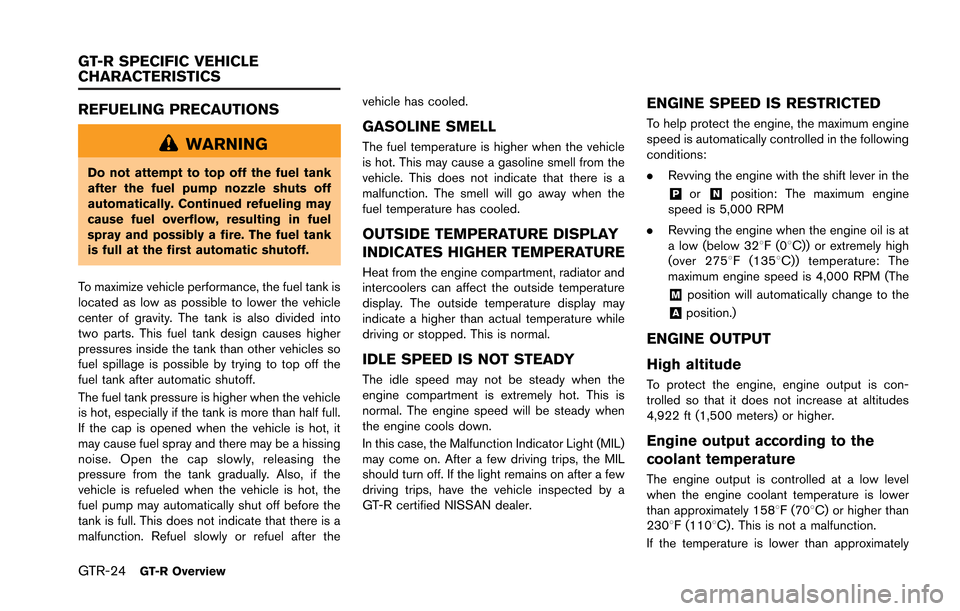
GTR-24GT-R Overview
REFUELING PRECAUTIONS
WARNING
Do not attempt to top off the fuel tank
after the fuel pump nozzle shuts off
automatically. Continued refueling may
cause fuel overflow, resulting in fuel
spray and possibly a fire. The fuel tank
is full at the first automatic shutoff.
To maximize vehicle performance, the fuel tank is
located as low as possible to lower the vehicle
center of gravity. The tank is also divided into
two parts. This fuel tank design causes higher
pressures inside the tank than other vehicles so
fuel spillage is possible by trying to top off the
fuel tank after automatic shutoff.
The fuel tank pressure is higher when the vehicle
is hot, especially if the tank is more than half full.
If the cap is opened when the vehicle is hot, it
may cause fuel spray and there may be a hissing
noise. Open the cap slowly, releasing the
pressure from the tank gradually. Also, if the
vehicle is refueled when the vehicle is hot, the
fuel pump may automatically shut off before the
tank is full. This does not indicate that there is a
malfunction. Refuel slowly or refuel after the vehicle has cooled.
GASOLINE SMELL
The fuel temperature is higher when the vehicle
is hot. This may cause a gasoline smell from the
vehicle. This does not indicate that there is a
malfunction. The smell will go away when the
fuel temperature has cooled.
OUTSIDE TEMPERATURE DISPLAY
INDICATES HIGHER TEMPERATURE
Heat from the engine compartment, radiator and
intercoolers can affect the outside temperature
display. The outside temperature display may
indicate a higher than actual temperature while
driving or stopped. This is normal.
IDLE SPEED IS NOT STEADY
The idle speed may not be steady when the
engine compartment is extremely hot. This is
normal. The engine speed will be steady when
the engine cools down.
In this case, the Malfunction Indicator Light (MIL)
may come on. After a few driving trips, the MIL
should turn off. If the light remains on after a few
driving trips, have the vehicle inspected by a
GT-R certified NISSAN dealer.
ENGINE SPEED IS RESTRICTED
To help protect the engine, the maximum engine
speed is automatically controlled in the following
conditions:
.
Revving the engine with the shift lever in the
&Por&Nposition: The maximum engine
speed is 5,000 RPM
. Revving the engine when the engine oil is at
a low (below 328F(0 8C)) or extremely high
(over 2758 F (1358C)) temperature: The
maximum engine speed is 4,000 RPM (The
&Mposition will automatically change to the
&Aposition.)
ENGINE OUTPUT
High altitude
To protect the engine, engine output is con-
trolled so that it does not increase at altitudes
4,922 ft (1,500 meters) or higher.
Engine output according to the
coolant temperature
The engine output is controlled at a low level
when the engine coolant temperature is lower
than approximately 1588F (708C) or higher than
2308F (1108C). This is not a malfunction.
If the temperature is lower than approximately
GT-R SPECIFIC VEHICLE
CHARACTERISTICS
Page 96 of 346
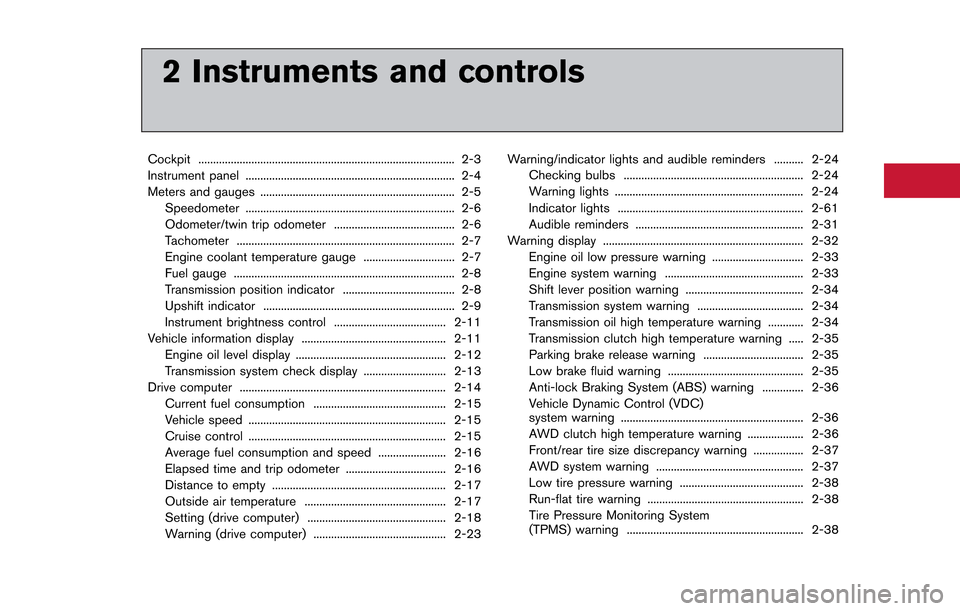
2 Instruments and controls
Cockpit ........................................................................\
............... 2-3
Instrument panel ....................................................................... 2-4
Meters and gauges .................................................................. 2-5Speedometer ....................................................................... 2-6
Odometer/twin trip odometer ......................................... 2-6
Tachometer ........................................................................\
.. 2-7
Engine coolant temperature gauge ............................... 2-7
Fuel gauge ........................................................................\
... 2-8
Transmission position indicator ...................................... 2-8
Upshift indicator ................................................................. 2-9
Instrument brightness control ...................................... 2-11
Vehicle information display ................................................. 2-11 Engine oil level display ................................................... 2-12
Transmission system check display ............................ 2-13
Drive computer ...................................................................... 2-14 Current fuel consumption ............................................. 2-15
Vehicle speed ................................................................... 2-15
Cruise control ................................................................... 2-15
Average fuel consumption and speed ....................... 2-16
Elapsed time and trip odometer .................................. 2-16
Distance to empty ........................................................... 2-17
Outside air temperature ................................................ 2-17
Setting (drive computer) ............................................... 2-18
Warning (drive computer) ............................................. 2-23 Warning/indicator lights and audible reminders .......... 2-24
Checking bulbs ............................................................. 2-24
Warning lights ................................................................ 2-24
Indicator lights ............................................................... 2-61
Audible reminders ......................................................... 2-31
Warning display .................................................................... 2-32
Engine oil low pressure warning ............................... 2-33
Engine system warning ............................................... 2-33
Shift lever position warning ........................................ 2-34
Transmission system warning .................................... 2-34
Transmission oil high temperature warning ............ 2-34
Transmission clutch high temperature warning ..... 2-35Parking brake release warning .................................. 2-35
Low brake fluid warning .............................................. 2-35
Anti-lock Braking System (ABS) warning .............. 2-36
Vehicle Dynamic Control (VDC)
system warning .............................................................. 2-36
AWD clutch high temperature warning ................... 2-36
Front/rear tire size discrepancy warning ................. 2-37
AWD system warning .................................................. 2-37
Low tire pressure warning .......................................... 2-38
Run-flat tire warning ..................................................... 2-38Tire Pressure Monitoring System
(TPMS) warning ............................................................ 2-38
Page 128 of 346
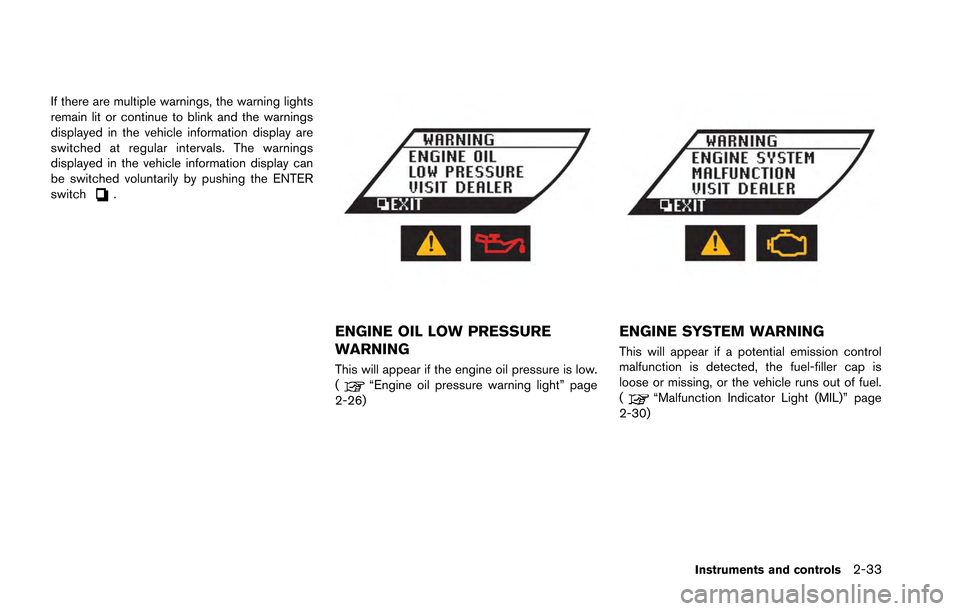
If there are multiple warnings, the warning lights
remain lit or continue to blink and the warnings
displayed in the vehicle information display are
switched at regular intervals. The warnings
displayed in the vehicle information display can
be switched voluntarily by pushing the ENTER
switch
.
ENGINE OIL LOW PRESSURE
WARNING
This will appear if the engine oil pressure is low.
(“Engine oil pressure warning light” page
2-26)
ENGINE SYSTEM WARNING
This will appear if a potential emission control
malfunction is detected, the fuel-filler cap is
loose or missing, or the vehicle runs out of fuel.
(
“Malfunction Indicator Light (MIL)” page
2-30)
Instruments and controls2-33
Page 194 of 346
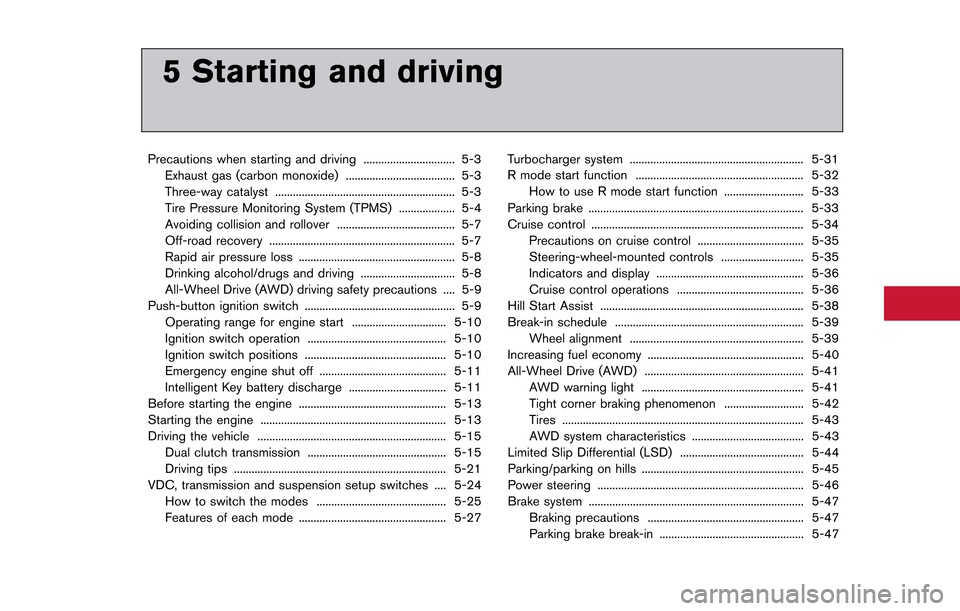
5 Starting and driving
Precautions when starting and driving ............................... 5-3Exhaust gas (carbon monoxide) ..................................... 5-3Three-way catalyst ............................................................. 5-3
Tire Pressure Monitoring System (TPMS) ................... 5-4
Avoiding collision and rollover ........................................ 5-7
Off-road recovery ............................................................... 5-7
Rapid air pressure loss ..................................................... 5-8
Drinking alcohol/drugs and driving ................................ 5-8All-Wheel Drive (AWD) driving safety precautions .... 5-9
Push-button ignition switch ................................................... 5-9
Operating range for engine start ................................ 5-10
Ignition switch operation ............................................... 5-10
Ignition switch positions ................................................ 5-10
Emergency engine shut off ........................................... 5-11
Intelligent Key battery discharge ................................. 5-11
Before starting the engine .................................................. 5-13
Starting the engine ............................................................... 5-13
Driving the vehicle ................................................................ 5-15 Dual clutch transmission ............................................... 5-15
Driving tips ........................................................................\
5-21
VDC, transmission and suspension setup switches .... 5-24 How to switch the modes ............................................ 5-25
Features of each mode .................................................. 5-27 Turbocharger system ........................................................... 5-31
R mode start function ......................................................... 5-32
How to use R mode start function ........................... 5-33
Parking brake ........................................................................\
. 5-33
Cruise control ........................................................................\
5-34 Precautions on cruise control .................................... 5-35
Steering-wheel-mounted controls ............................ 5-35
Indicators and display .................................................. 5-36
Cruise control operations ........................................... 5-36
Hill Start Assist ..................................................................... 5-38
Break-in schedule ................................................................ 5-39 Wheel alignment ........................................................... 5-39
Increasing fuel economy ..................................................... 5-40
All-Wheel Drive (AWD) ...................................................... 5-41 AWD warning light ....................................................... 5-41
Tight corner braking phenomenon ........................... 5-42
Tires ........................................................................\
.......... 5-43AWD system characteristics ...................................... 5-43
Limited Slip Differential (LSD) .......................................... 5-44
Parking/parking on hills ....................................................... 5-45
Power steering ...................................................................... 5-46
Brake system ........................................................................\
. 5-47 Braking precautions ..................................................... 5-47
Parking brake break-in ................................................. 5-47
Page 197 of 346

5-4Starting and driving
WARNING
.The exhaust gas and the exhaust
system are very hot. Keep people,
animals or flammable materials
away from the exhaust system com-
ponents.
. Do not stop or park the vehicle over
flammable materials such as dry
grass, waste paper or rags. They
may ignite and cause a fire.
NOTICE
.Do not use leaded gasoline. Depos-
its from leaded gasoline seriously
reduce the three-way catalyst’s abil-
ity to help reduce exhaust pollu-
tants.
. Keep your engine tuned up. Mal-
functions in the ignition, fuel injec-
tion, or electrical systems can cause
overrich fuel flow into the three-way
catalyst, causing it to overheat. Do
not keep driving if the engine mis-
fires, or if noticeable loss of perfor-
mance or other unusual operating conditions are detected. Have the
vehicle inspected promptly by a
GT-R certified NISSAN dealer.
. Avoid driving with an extremely low
fuel level. Running out of fuel could
cause the engine to misfire, dama-
ging the three-way catalyst.
. Do not race the engine while warm-
ing it up.
. Do not push or tow your vehicle to
start the engine.
TIRE PRESSURE MONITORING
SYSTEM (TPMS)
Each tire should be checked monthly when cold
and inflated to the inflation pressure recom-
mended by the vehicle manufacturer on the
vehicle placard or tire inflation pressure label. (If
your vehicle has tires of a different size than the
size indicated on the vehicle placard or tire
inflation pressure label, you should determine
the proper tire inflation pressure for those tires.)
As an added safety feature, your vehicle has
been equipped with a Tire Pressure Monitoring
System (TPMS) that illuminates a low tire
pressure telltale when one or more of your tires
is significantly under-inflated. Accordingly, when the low tire pressure telltale illuminates, you
should stop and check your tires as soon as
possible, and inflate them to the proper pres-
sure. Driving on a significantly under-inflated tire
causes the tire to overheat and can lead to tire
failure. Under-inflation also reduces fuel effi-
ciency and tire tread life, and may affect the
vehicle’s handling and stopping ability.
If the vehicle is being driven with one or more flat
tires, the run-flat tire warning light will illuminate
continuously and a chime will sound for 10
seconds. The chime will only sound at the first
indication of a flat tire, and the warning light will
illuminate continuously. When the Flat tire
warning is activated, have the system reset
and the tire checked and replaced if necessary
by a GT-R certified NISSAN dealer. Even if the
tire is inflated to the specified COLD tire
pressure, the warning light will continue to
illuminate until the system is reset by a GT-R
certified NISSAN dealer. Your vehicle can be
driven for a limited time on a flat tire. (
“Run-
flat tires” page 8-37)
Please note that the TPMS is not a substitute for
proper tire maintenance, and it is the driver’s
responsibility to maintain correct tire pressure,
even if under-inflation has not reached the level
to trigger illumination of the TPMS low tire
pressure telltale.
Page 233 of 346
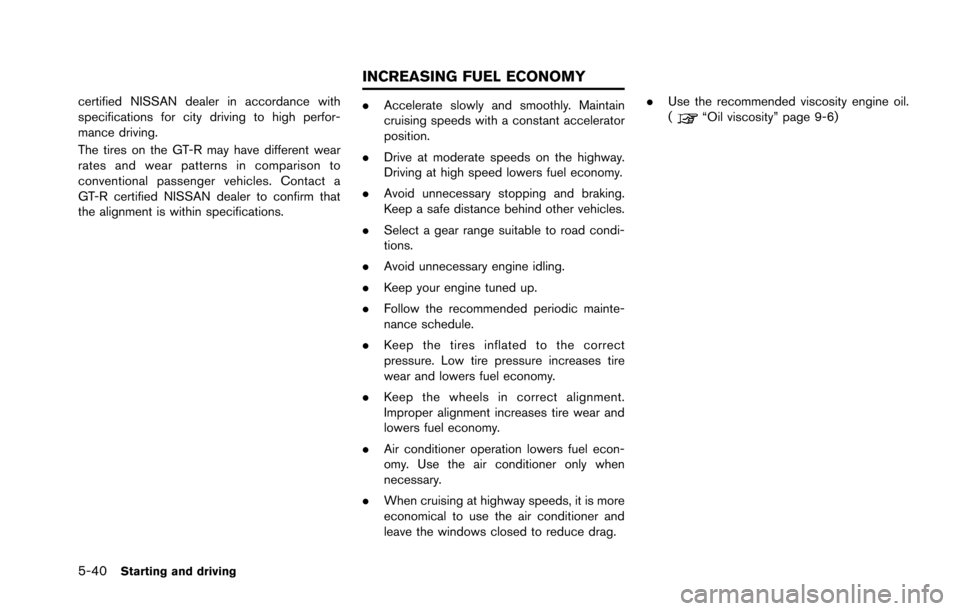
5-40Starting and driving
certified NISSAN dealer in accordance with
specifications for city driving to high perfor-
mance driving.
The tires on the GT-R may have different wear
rates and wear patterns in comparison to
conventional passenger vehicles. Contact a
GT-R certified NISSAN dealer to confirm that
the alignment is within specifications..Accelerate slowly and smoothly. Maintain
cruising speeds with a constant accelerator
position.
. Drive at moderate speeds on the highway.
Driving at high speed lowers fuel economy.
. Avoid unnecessary stopping and braking.
Keep a safe distance behind other vehicles.
. Select a gear range suitable to road condi-
tions.
. Avoid unnecessary engine idling.
. Keep your engine tuned up.
. Follow the recommended periodic mainte-
nance schedule.
. Keep the tires inflated to the correct
pressure. Low tire pressure increases tire
wear and lowers fuel economy.
. Keep the wheels in correct alignment.
Improper alignment increases tire wear and
lowers fuel economy.
. Air conditioner operation lowers fuel econ-
omy. Use the air conditioner only when
necessary.
. When cruising at highway speeds, it is more
economical to use the air conditioner and
leave the windows closed to reduce drag. .
Use the recommended viscosity engine oil.
(“Oil viscosity” page 9-6)
INCREASING FUEL ECONOMY